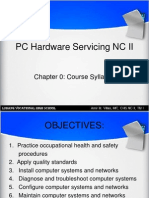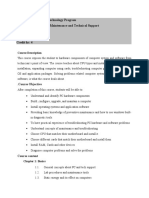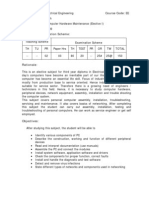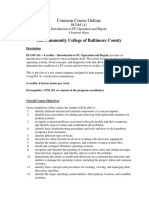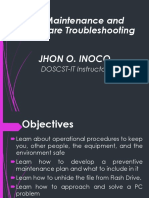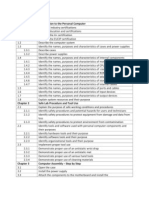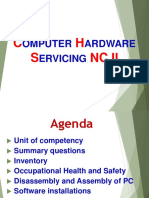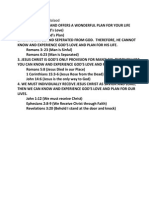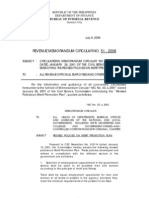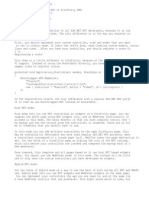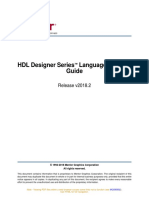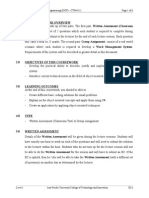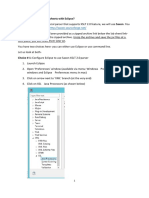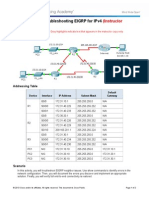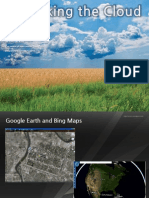COURSE DURATION : 40 HRS
MODULE 1 - KB0101: PC Hardware & Software Troubleshooting &
Repair w/ OJT
COURSE DECRIPTION:
This Hands-On training teaches you everything you need to know to become
an expert Technical Support Staff. It covers Basic to Advanced
troubleshooting and servicing strategies. You need no further PC Repair
training after completing this course. This course is an unselfish transfer of
technology from CNCTC Inc through its experienced IT Trainers at a
reasonable price. It is a two course training merge into one training.
This course will help you prepare for TESDA CHS NCII Assessment Exam
COURSE DELIVERY:
Instructor-led, Hands-On training approach.
COURSE PREREQUISITE:
Familiarity with Windows Operating System
High Level interest in learning
LIBRARY: Available
INTERNET ACCESS: Available
COURSE OUTLINE
MODULE 1.1 - ADVANCED PC ASSEMBLY, HARDWARE
CONFIGURATION & SERVICING
Chapter 1 - Introduction
Common PC errors
Types of Personal computers
Identifying key parts of a Personal Computer
Basic Software components
Overview of PC Operations
Operating Systems (OS)
Disk Operating System (DOS) How DOS works
Chapter 2 - CPU CASE AND POWER SUPPLY
Types of PC case
Functions of a CPU Case
Front Panel connectors
Removing CPU Case
Cleaning the PC case
PC Cooling System
PC Cooling system maintenance
Power Supply
Common Power Supply problems
Chapter 3 -
The PROCESSOR
Types of CPU x86, Celeron, Pentium I-IV, Itanium, Duron, Sempron,
Athlon CPU speed
CPU socket/slot types
Comparing different types of CPU
How to identify CPUs physically
Physical installation of CPU
Installing CPU fan
CPU Benchmarking
CPU Overclocking
Upgrading CPU
CPU maintenance
CPU cleaning procedures
Troubleshooting & testing CPU using processor diagnostic test
Chapter 4 - The MOTHERBOARD
Types of motherboards
Motherboard layout, form factors
Motherboard Identification
Motherboard components
ROM BIOS
Motherboard BUSSES
Configuring motherboard jumper settings
Upgrading motherboards
Signs of trouble with the motherboard
Common motherboard problems
Motherboard Maintenance
Motherboard Cleaning procedures
Troubleshooting and testing motherboards
Chapter 5
The MEMORY
Types of Memory
Comparing different types of memory
Memory identification
Adding and Removing Memory
Memory packaging
Memory upgrading
Memory Maintenance
Memory cleaning procedures
Determine failed memory devices using memory diagnostics test
Troubleshooting RAM errors
Chapter 6 - STORAGE DEVICES
The HARD DRIVES
Types of hard drives
Hard drive manufacturers
Hard Drive Identification
Identifying drive capacity
Hard drive controllers
IDE/SCSI cables
Hard drive configuration (Master/Slave layout)
Hard drive installation
Upgrading to large Hard-disks
Optimizing hard disk performance
Hard drive maintenance
Hard drives problems troubleshooting and repairing
The FLOPPY DRIVES
Types of diskettes
Floppy drive identification
Floppy drive controller
Setting drives and cable orientation
Replacing a floppy drive
Floppy disk and drive Care
Floppy drive maintenance
Floppy drive cleaning procedures
Floppy drive problems and solutions
Chapter 7 - OTHER DATA STORAGE DEVICES
CDROM drive
DVD/DVD+R/RW drive
CD-R drive
CD-RW drive
CD/DVD controllers
CD/DVD configuration (Master/Slave layout)
CD/DVD installation and upgrading
Transfer Speed
Device Data throughput
CDROM maintenance
CDROM cleaning procedures
Trouble shooting and repairing common
CDROM drive problems
REMOVABLE DRIVES
Troubleshooting External Storage device
Chapter 8 - I/O DEVICES & DISPLAYS
PC MONITOR
Keyboards
Connecting keyboards
Keyboard maintenance
Keyboard cleaning procedure
Troubleshooting and Repairing common keyboard errors
Joysticks
Web Cams
Connecting a Web Cam
Maintenance of a Web Cam
Speakers
Connecting Speakers
Maintenance of speakers
Printers
Types of printers
Installing a printer
Diagnosing Printer problems
Solving common printer problems
Mouse
Mouse interfaces (PS2, Serial, USB and wireless)
Mouse cleaning procedures
Troubleshooting and repairing common mouse problems
Chapter 9 -
EXPANSION CARDS/PERIPHERAL DEVICES
Expansion Slots
Proper insertion of expansion card
Replacing and removing expansion card
Display /Video or Graphics card
Graphics adapter installation
Adding ad Removing video card
Display card Maintenance
Display card cleaning
Symptoms of trouble with display adapter
Common problems of graphics adapter
TV Cards
Adding and Removing TV tuner card
Sound Cards
Adding and Removing Sound card
LAN Cards
Adding and Removing LAN card
Modem
Adding and removing Internal modem
Adding and removing External modem
Scanner
Chapter 10 -
PC PORTS
Serial Port
Configuring Serial port
Symptoms of trouble with serial port
Repairing common serial ports problems
Adding and replacing serial ports
Parallel Port
Configuring parallel port
Symptoms of trouble with parallel port
Repairing common parallel port errors
Adding parallel port
USB Port
Symptoms of trouble with USB port
Repairing common USB errors
Firewire Port
Symptoms of trouble with Firewire port
Chapter 11 -
PC Assembly/Disassembly
Safety Concerns
Heat Factors
Static Electricity
Electro Static Discharge (ESD)
Radio Frequency Interference
AC Power
Spikes, Brownouts, Blackouts
UPS
Common errors occurring after PC Assembly
Properly assemble a Personal Computer
Properly disassemble a Personal Computer
Chapter 12 -
BIOS/CMOS Management
BIOS
Function of a BIOS
Accessing CMOS Setup
Navigating and Changing CMOS values
Upgrading the BIOS
Troubleshooting system faults using POST
BIOS and POST codes
Using POST audio and Video error codes
Standard IBM POST error codes
Determining what POST can not test
Upgrading the BIOS
Chapter 13 -
Advance PC HARDWARE Servicing
PC Troubleshooting strategy
Designing a troubleshooting methodology
Establishing where to begin the testing
Determining common causes of failures
Finding and isolating the board with the problem
Utilizing advance diagnostic programs to test for:
Solving Interrupt (IRQ) and I/O conflicts
MODULE 1.2 - ADVANCED PC SOFTWARE CONFIGURATION,
TROUBLESHOOTING & DATA RECOVERY
Chapter 1 - Introduction
Common Windows errors
Desktop Operating Systems
Network Operating Systems
Overview of Windows Operating System
Windows Boot Process
Windows configuration files
Windows core files
Windows System Directories
Chapter 2 - DOS Essentials
MS-DOS Overview
Function of DOS
DOS boot process
DOS system files
DOS interface (CLI)
Types of DOS commands
Common DOS commands
Common DOS errors
Chapter 3 - Windows File Systems
FAT (File Allocation Table)
Types of File Systems (FAT16, FAT32, VFAT,
NTFS4, NTFS5 & HPFS)
File System Care
Checking the drive for errors
Supported File Systems of different versions of Microsoft Windows
Chapter 4 - HARD DISK MANAGEMENT & CONFIGURATIONS
Hard disk configurations
Hard disk partition
Primary Partition
Extended Partition
Logical Drive
Volume
Preparing a brand new hard drive
Partitioning a Hard Drive
Formatting a Hard Drive
Deleting Hard Disk partitions
Hard Disk Diagnostic test
Repairing the Master Boot Record
Fixing a damaged partition table
Repairing Hard Disk with Bad Sectors
Low-level Formatting a drive
Chapter 5 - Operating System Installations and upgrades
Hardware requirements
Hardware compatibility
Common errors during installation
Installing Windows 98
Upgrading Windows 98
Installing Windows XP
Chapter 6 - Hardware Device Driver Installation
What is a Device driver?
Function of a device driver
Determining hardware model & manufacturer
Where to find Hardware drivers
Searching for drivers in the internet
Installing device drivers (Video card, LAN card, Modem, printers etc..)
Post-install operations
Chapter 7 - Software Installation
Software compatibility
Hardware requirements
Dealing with failed installation
Installation methods (Control Panel, Installer)
Installing Software (MS-Office, Anti-Virus, Network games programs
etc..)
Software updates and Service packs
Uninstalling Software
Dealing with failed uninstallation
Manual Removal of installed Software
Chapter 8 -
Virus Management: Detecting and Removing
What is a virus?
Types of virus
Spyware, Adware, malware viruses
Preventing Virus infections
Protecting Key System files
Checking for Macro viruses missed by anti-virus programs
Protecting against script based virus.
Symptoms of an infected computer
Deciding what anti-virus program to install
Installing Anti-Virus programs
Installing Anti-Spyware, Malware and Adware program.
Diagnosing, Treating and Removing Virus infections
Chapter 9 - DATA RECOVERY Concept
How disk drives work
Understanding Tracks, Sectors, Cylinders and Clusters
Master Boot Record
Partition table
Troubleshooting strategy concepts
Running Scandisk to check for disk errors
Correcting errors reported by scandisk
Causes and symptoms of a corrupted FAT
Repairing lost and cross-linked files
Surviving Disk Disasters
Understanding Disk error messages
Creating emergency rescue disk
Using Disk repair tools
Recovering Files and Directories
Recovering erased Files
Transferring recovered files to backup disk
Editing Disk sectors
Reviving non-bootable disk
Repairing the Master Boot Record
Fixing a damaged partition table
Dealing with accidental Reformatting
Unformatting a drive
Removing Disk Fragmentation
Using Backup utility program
Fixing common disk problems
Solving ?Invalid drive specification
Chapter 10 - Configuring and Troubleshooting WINDOWS
General Troubleshooting Methodology
What to do when Windows failed to start
Windows Plug n Play Architecture
Windows boot files
Windows Start-up process
Troubleshooting Windows Start-up problems
Dual booting Windows 98 with Windows XP/2000
Creating Emergency Repair Disk (ERD)
Solving common Windows errors
Windows XP Administrative Tools
Computer Management Console (Adding, Editing and deleting
partitions)
System Tools, Services and applications
�Chapter 11 - The WINDOWS REGISTRY
What is a Registry?
Registry entry structure
Modifying Registry Entries with Regedit and Regedit32
Backing up registry entries
Preventing registry backup failures
Repairing corrupted Registry files
Removing Unwanted Registry entries
Solving Registry entry conflicts
Chapter 12 - DISK IMAGING/CLONING
Disk Cloning Concept
Advantages of Disk Cloning
Issues to consider before cloning a drive
Preparing for Disk Cloning
Disk Cloning Software
Disk Cloning using GHOST
Dealing with accidental or mistakenly cloned drive (Uncloning a drive)
Common disk cloning errors
Solving Disk Cloning failures
MODULE 2 - KB0103: PC LAN/WAN Setup & Windows 2008 Server
Admin (Active Directory)
COURSE DESCRIPTION:
�This HANDS-ON training gives you the knowledge and skills to design, build,
configure and implement a Local Area Network/WAN. The training starts
from the ground up, from planning to purchasing to designing and to cabling
the network and to configuring the network so that it will be up and running.
The training does not stop there because it includes Implementing,
Configuring and Administering a Windows 2008 Active Directory
Infrastructure It teaches you all you need to know to administer a Windows
2003 Network.
This course will help you prepare for TESDA CHS NCII Assessment Exam
COURSE DELIVERY:
Instructor-led, Hands-On training approach.
COURSE PREREQUISITE:
PC Hardware and Software Troubleshooting and Repair Training
COURSE OUTLINE
MODULE 2.1: NETWORK TECHNOLOGY, DESIGN/CABLING &
WIRELESS LAN SETUP
Chapter 1: Introduction to Local Area Network
Defining a Local Area Network
Application of PC Networking
Organization-wide computing
Workgroup computing
Resource sharing
Distance Learning
FTP and Web Access
Differentiating LAN, MAN and WAN
Network Standards
Network Operating Systems (NOS)
Characteristics of a NOS
Desktop Operating Systems (Client Operating System)
Chapter 2: Understanding Network components for LAN connectivity
Client for Microsoft Networks
Network Adapter
Network Protocol (TCP/IP)
File and Printer sharing for Microsoft Networks
Chapter 3: Configuring Network components
Installing Client for Microsoft Networks
Installing Network Adapter
Installing and configuring TCP/IP
Installing File and Printer Sharing for Microsoft
Networks
Setting Workgroup names and Computer names
Common errors in building a Network
Solving Network Connection problems
Chapter 4: TCP/IP & Subnetting
TCP/IP Overview
Function of TCP/IP in a Network
Static and Dynamic IP Addresses
Class A, B, C and D
Differentiating IP address classes
Network ID's and Hosts
Choosing Private IP addresses
Assigning IP addresses
IP Subnetting
Subnetting Class A, B & C address
Defining Subnet Masks
Troubleshooting TCP/IP
Using Network utilities (ping, tracert, ipconfig, arp,
nbtstat etc..)
Chapter 5: INTERNET CONNECTION SHARING
Overview of the Internet
Internet Service Providers (ISP)
Requirements for Internet connection (Modem, Tel.
Line, ISP account)
Dial-up Internet connection
Broadband Internet connection (Cable/DSL)
Dial-up Internet connection setup
Cable and DSL internet connection setup
Common errors in connecting to the Internet
Solving common internet connection failures
Sharing Internet Connection using a ROUTER
Configuring a DSL Router
Managing IP address of DSL Router
Configuring the embedded DHCP server in the Router
Managing advanced features of the Router
Sharing Internet Connection using Wingate software
Configuring the Wingate server
Configuring the Wingate client
Testing for internet connection of the network
Common Internet sharing problems
Solving Internet connection errors
Chapter 6: NETWORK DESIGN AND CABLING
LAN Standards
Multi-LAN Networks and configuration
Backbone Designs
High-Speed LAN
Defining LAN requirements
Determining user needs
Network Hardware
Network Topology (Star, Bus, Ring and Tree)
Cabling the Network
Testing the Cable
Testing the Network
Post Installation operations
Chapter 7: WIRELESS LAN SETUP AND CONFIGURATION
MODULE 2.2 - WINDOWS 2008 SERVER ADMINISTRATION (Active
Directory Infrastructure)
CHAPTER 1: Configuring Domain Name System (DNS) for Active Directory
Configure zones
Dynamic DNS (DDNS), Non-dynamic DNS (NDDNS) and Secure Dynamic DNS
(SDDNS);
Primary, Secondary, Active Directory Integrated, Stub;
forward lookup and reverse lookup zones
Configure DNS server settings
Forwarding;
root hints;
configure zone delegation;
disable recursion;
server scavenging
Configure zone transfers and replication
Configure replication scope (forestDNSzone; domainDNSzone);
incremental zone transfers
secure zone transfers
CHAPTER 2: Configuring the Active Directory infrastructure
Configure a forest or a domain
Remove a domain;
perform an unattended installation;
Active Directory Migration Tool (ADMT);
change forest and domain functional levels;
interoperability with previous versions of Active Directory;
Configure trusts
Forest trust;
selective authentication vs. forest-wide authentication;
transitive trust; external trust; shortcut trust;
Configure sites
Create Active Directory subnets;
configure sites infrastructure
Configure Active Directory replication
DFSR;
one-way replication;
Bridgehead server;
replication scheduling;
Configure operations masters
Seize and transfer;
backup operations master;
operations master placement;
Schema Master;
�CHAPTER 3: Configuring Active Directory roles and services
Configure Active Directory Lightweight Directory Service (AD LDS)
Migration to AD LDS;
configure data within AD LDS;
configure an authentication server;
Server Core installation
Configure the read-only domain controller (RODC)
Replication;
Administrator role separation;
read-only DNS;
credential caching;
password replication;
read-only SYSVOL;
staged install
CHAPTER 4: Creating and maintaining Active Directory objects
Automate creation of Active Directory accounts
create computer, user and group accounts (scripts, import, migration);
offline domain join
Maintain Active Directory accounts
Manage computer accounts;
configure group membership;
account resets;
local vs. domain;
Protected Admin;
disabling accounts vs. deleting accounts;
creating organisational units (OUs);
delegation of control;
protecting AD objects from deletion;
Create and apply Group Policy objects (GPOs)
setting up Group Policies for Domain/OU
Enforce, OU hierarchy, block inheritance and enabling user objects;
group policy processing priority;
group policy filtering;
Configure GPO templates
User rights;
ADMX Central Store;
administrative templates;
security templates;
restricted groups;
security options;
Deploy and manage software by using GPOs
Publishing to users;
assigning software to users;
Configure account policies
Domain password policy;
account lockout policy;
fine-grain password policies
Configure audit policy by using GPOs
audit account logon events;
audit policy change;
audit access privilege use;
audit object access;
COURSE FEE:
with FREE Flowing Coffee
Cash
Installment Downpayment
Php15,000 Php15,500 Php7,500
COURSE SCHEDULES:
Due Date
Midway of training
Manual
Free







